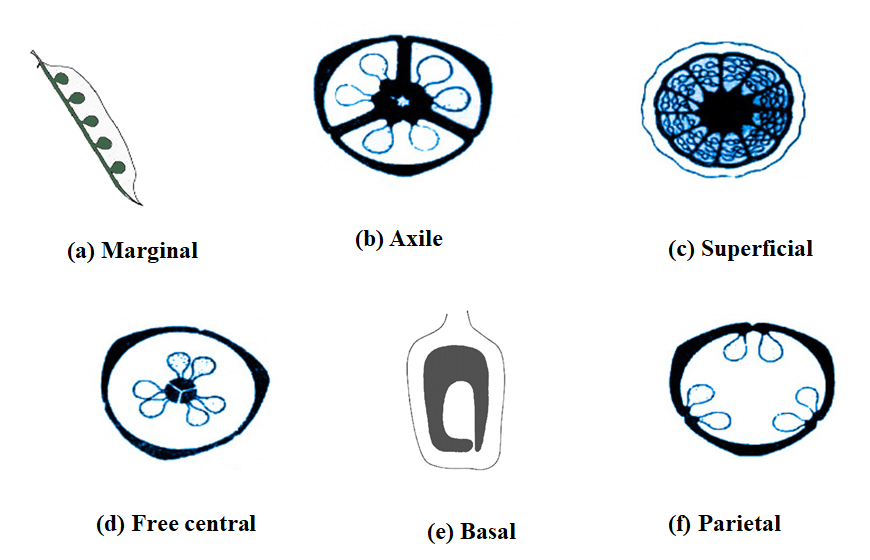
Axile placentation is found in:
(a) Cassia fistula
(b) Hibiscus rosa-Sinensis
(c) Helianthus annuus
(d) Dalbergia sissoo
Answer
492.9k+ views
Hint: The arrangement of tissues in the ovary in which the placenta is axial with the ovules attached to it is called Axile placentation. It is very common in plants of the family Malvaceae.
Complete step by step answer:
The arrangement of ovules inside the ovary is called placentation. There are various types of placentation out of which axle is also one. It is very common in plants of the family Malvaceae. In this type, the ovules are arranged as-
This is seen in Hibiscus rosa-sin:ensis or which we simply call as Hibiscus flower.
Other types of placentation are:
Marginal placentation: Ovules are arranged in such a way that the placenta forms a ridge-like structure and ovules are formed on these ridges in rows. It is found in Cassia fistula and in Dalbergia sissoo.
Parietal placentation: Ovules are arranged on the inner or peripheral walls of the ovary. There is the formation of a pseudo septum which makes it look two-chambered but originally the ovary is single-chambered.
Basal placentation: The placenta develops at the base of the ovary and a single ovule is attached to it. It is found in Helianthus annuus.
Free central placentation: Ovules develop on the central axis and the septum is not present. It is found in Dianthus.

So, the correct answer is ‘(b) Hibiscus rosa-Sinensis’.
Note: The type of placentation i.e. arrangement of ovules has a significant influence on the shape and morphology of a fruit which forms as a result of fertilization. By knowing the type of placentation, the morphology of the fruit can be predicted.
Complete step by step answer:
The arrangement of ovules inside the ovary is called placentation. There are various types of placentation out of which axle is also one. It is very common in plants of the family Malvaceae. In this type, the ovules are arranged as-
This is seen in Hibiscus rosa-sin:ensis or which we simply call as Hibiscus flower.
Other types of placentation are:
Marginal placentation: Ovules are arranged in such a way that the placenta forms a ridge-like structure and ovules are formed on these ridges in rows. It is found in Cassia fistula and in Dalbergia sissoo.
Parietal placentation: Ovules are arranged on the inner or peripheral walls of the ovary. There is the formation of a pseudo septum which makes it look two-chambered but originally the ovary is single-chambered.
Basal placentation: The placenta develops at the base of the ovary and a single ovule is attached to it. It is found in Helianthus annuus.
Free central placentation: Ovules develop on the central axis and the septum is not present. It is found in Dianthus.

So, the correct answer is ‘(b) Hibiscus rosa-Sinensis’.
Note: The type of placentation i.e. arrangement of ovules has a significant influence on the shape and morphology of a fruit which forms as a result of fertilization. By knowing the type of placentation, the morphology of the fruit can be predicted.
Recently Updated Pages
Master Class 11 Economics: Engaging Questions & Answers for Success

Master Class 11 Business Studies: Engaging Questions & Answers for Success

Master Class 11 Accountancy: Engaging Questions & Answers for Success

Master Class 11 English: Engaging Questions & Answers for Success

Master Class 11 Computer Science: Engaging Questions & Answers for Success

Master Class 11 Maths: Engaging Questions & Answers for Success

Trending doubts
State and prove Bernoullis theorem class 11 physics CBSE

What are Quantum numbers Explain the quantum number class 11 chemistry CBSE

Write the differences between monocot plants and dicot class 11 biology CBSE

Why is steel more elastic than rubber class 11 physics CBSE

Explain why a There is no atmosphere on the moon b class 11 physics CBSE

1 ton equals to A 100 kg B 1000 kg C 10 kg D 10000 class 11 physics CBSE




